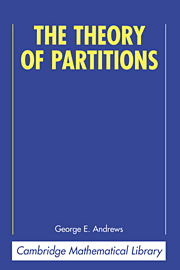Book contents
- Frontmatter
- Editor's Statement
- Contents
- Preface to Paperback Edition
- Preface
- Chapter 1 The Elementary Theory of Partitions
- Chapter 2 Infinite Series Generating Functions
- Chapter 3 Restricted Partitions and Permutations
- Chapter 4 Compositions and Simon Newcomb's Problem
- Chapter 5 The Hardy–Ramanujan–Rademacher Expansion of p(n)
- Chapter 6 The Asymptotics of Infinite Product Generating Functions
- Chapter 7 Identities of the Rogers–Ramanujan Type
- Chapter 8 A General Theory of Partition Identities
- Chapter 9 Sieve Methods Related to Partitions
- Chapter 10 Congruence Properties of Partition Functions
- Chapter 11 Higher–Dimensional Partitions
- Chapter 12 Vector or Multipartite Partitions
- Chapter 13 Partitions in Combinatorics
- Chapter 14 Computations for Partitions
- Index for Definitions of Symbols
- Author Index
- Subject Index
Preface to Paperback Edition
Published online by Cambridge University Press: 10 February 2010
- Frontmatter
- Editor's Statement
- Contents
- Preface to Paperback Edition
- Preface
- Chapter 1 The Elementary Theory of Partitions
- Chapter 2 Infinite Series Generating Functions
- Chapter 3 Restricted Partitions and Permutations
- Chapter 4 Compositions and Simon Newcomb's Problem
- Chapter 5 The Hardy–Ramanujan–Rademacher Expansion of p(n)
- Chapter 6 The Asymptotics of Infinite Product Generating Functions
- Chapter 7 Identities of the Rogers–Ramanujan Type
- Chapter 8 A General Theory of Partition Identities
- Chapter 9 Sieve Methods Related to Partitions
- Chapter 10 Congruence Properties of Partition Functions
- Chapter 11 Higher–Dimensional Partitions
- Chapter 12 Vector or Multipartite Partitions
- Chapter 13 Partitions in Combinatorics
- Chapter 14 Computations for Partitions
- Index for Definitions of Symbols
- Author Index
- Subject Index
Summary
In the past twenty years, the theory of partitions has blossomed. The object of this book, as appropriate in this series, is to provide the fundamentals in a form accessible to the nonspecialist, with references to the recent literature for those who wish to pursue a particular interest. The major changes I would have made in a total revision would have added greatly to the length of the book. This is a task of such magnitude that it will have to wait until a number of my other projects are completed.
In the light of this introduction, here are my comments on the chapters of the third printing of The Theory of Partitions. Chapter 1 contains the almost immutable basics. Chapter 2 is partially devoted to basic hypergeometric series. As such, it is a small introduction to the wonderful world of q that has been so beautifully chronicled by Gasper and Rahman (1990). Andrews (1986) provides a further survey of the interactions of partitions with q. For Chapter 3, it should be pointed out that O'Hara (1990) has shown how to prove the unimodality of Gaussian polynomials in a purely elementary (although not easy) manner. Chapters 3 through 5 are fairly current introductions to their topics.
The work in Chapter 6 has been greatly extended by Richard McIntosh in a series of papers: cf. McIntosh (1995). The material in Chapters 7, 8, and 9 has also been greatly esxtended in the past decade.
- Type
- Chapter
- Information
- The Theory of Partitions , pp. xiii - xivPublisher: Cambridge University PressPrint publication year: 1984

